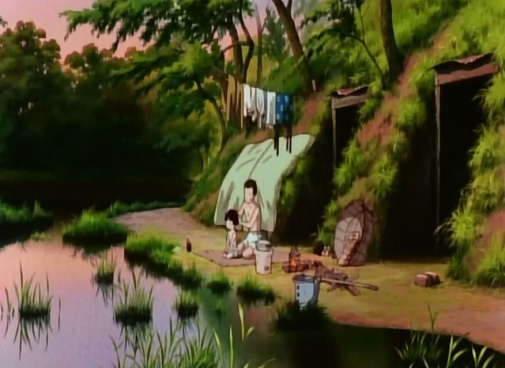Review: Grave of the Fireflies (Film)
After the American firebombing of Kobe, the village home to our protagonists, siblings Seita and Setsuko initially take refuge with relatives before setting out on their own to look after themselves in the countryside of wartime Japan.
In the wake of the initial firebombing, teenaged Seita and young Setsuko find their mother has been wounded to the point of no recovery. Within a few days she passes away quietly, although her loss rends an uproariously painful fracture in her children’s lives. With nowhere else to turn for shelter, the children resort to lodging with their paternal relatives, hoping for some peace and comfort.
However, under the domineering eye of their callous aunt, Seita and Setsuko realize their is no time for crying and no room for mourning as the war rages on, sapping every able-bodied citizen for work in factories or fighting on the frontlines, where the siblings’ own father has been directed prior to the opening scene, serving with the Imperial Japanese Navy.
In this environment of austerity and under pressure from their aunt to contribute, the siblings find themselves feeling stifled and uncentered, uncertain of their place without school or their mother to guide them. In an attempt to unburden their aunt, who increasingly hurls insults at the children, and also to create a touch of freedom for themselves, Seita takes Setsuko to make a home for themselves in an abandoned bomb shelter that’s been carved into the side of a hill.

It’s here in the shelter the siblings attempt to forge a new life for themselves, free of rules or overbearing guardians. In the beginning the shelter seems to offer everything they had hoped for as their days are full of fun and carefree abandon.
As time goes by, however, the siblings quickly run through their provisions, and their struggle for survival becomes terrifyingly grim as starvation soon sets in. In a bout of desperation Seita attempts to steal food from a nearby farm, only to be caught and beaten by the farmer in question. Although he is apprehended, he is later released and returns to his sister’s side, his sense of urgency only heightened as he takes note of her worsened state.
And despite Seita’s last-ditch efforts to get them both more food, as well as his noble intentions to always look after his sister, malnutrition and starvation continue to set in for both siblings, before claiming each of their lives in quick succession.
Throughout the film the devastation wrought by the war is not always immediately apparent as many villagers appear to carry on their routine working lives. However, the struggles appear in the rations imposed that impact daily affairs, in the countless children who must have been orphaned by the war, symbolized by the siblings. And despite the film’s gradual pace, the siblings’ status rapidly worsens towards the end, symbolizing most poignantly the fatal impact of the war.
The film is based on the partly-autobiographical short story of the same name by the late Japanese novelist Akiyuki Nosaka, who himself lived through World War II in Japan and similarly witnessed the death of his younger sister due to malnutrition. Although Nosaka has stated that he created Seita as the idealized version of himself, who could perform acts of generosity in taking care of his younger sister that Nosaka had wished but been unable to perform himself.
The plot is simple and yet no less searingly painful. In fact, the story’s simplicity perhaps even worsens its horrifying conclusion, as the narrative’s initial ebullience is juxtaposed with its tragic denouement. Despite the pain Seita and Setsuko endure there is also the boundless joy, the magic of their special bond that illuminates their forlorn path as the siblings refuse to sink into the desolation around them. When confronted with the hopelessness pervading not only the village, but the country, as represented by their aunt, the siblings withdraw into their own world, they create their own temporary happiness to carry them through their short-lived lives with levity and brightness, much like the fireflies they see at night.

This film is nothing short of a masterpiece, with a story that transcends time, language, place. It’s a heart-achingly beautiful testament to both the willfulness and fragility of the human spirit, refined in its simplicity and illuminated by its truthfulness. I’m certain that every viewer of this film will be deeply affected by its humanity.


One of the saddest movies I’ve ever seen. Still a wonderful film. Great review.
LikeLiked by 1 person